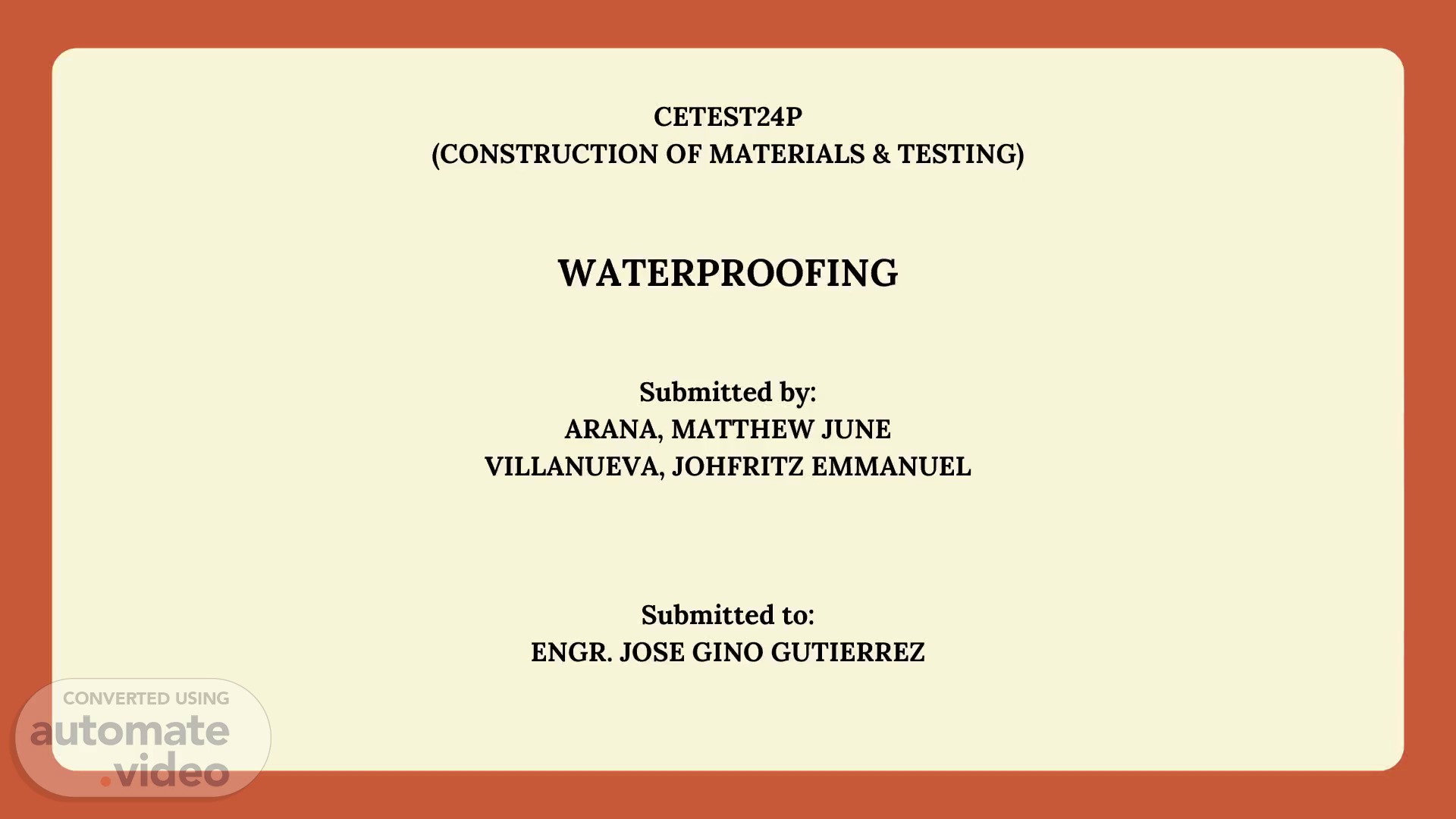
CETEST24P (CONSTRUCTION OF MATERIALS & TESTING) WATERPROOFING Submitted by: ARANA, MATTHEW JUNE VILLANUEVA, JOHFRITZ EMMANUEL Submitted to: ENGR. JOSE GINO GUTIERREZ
Scene 1 (0s)
. . CETEST24P. (CONSTRUCTION OF MATERIALS & TESTING).
Scene 2 (12s)
. . INTRODUCTION. Waterproofing means protection to prevent water entering in internal and external building structures such as toilets, swimming pools, water tanks, walls, ceilings etc. This creates a barrier that makes it impossible for water to pass through the material as this property prevents flooding and moisture in buildings..
Scene 3 (28s)
. . INTRODUCTION. Waterproofing is the process of making an object or structure waterproof or water-resistant so that it remains relatively unaffected by water or resisting the ingress of water under specified conditions. Such items may be used in wet environments or underwater to specified depths..
Scene 4 (42s)
. . INTRODUCTION. It helps in reducing the humidity inside the house, thus prevents damage to our indoors from exposure to moisture or water. In terms of the foundation, waterproofings means that no liquid will penetrate in the concrete foundation wall even under submerged conditions, the several products applied to foundations are called damp proofing..
Scene 5 (58s)
. . . TYPES OF WATERPROOFING. Cementitious Waterproofing.
Scene 6 (1m 6s)
. . TYPES OF WATERPROOFING. Cemented waterproofing is the simplest method of waterproofing, materials required are freely available, easy to mix and apply. It is usually rigid or semi-flexible waterproofings hence used at interior places such as toilets & areas not exposed to sunlight and weathering..
Scene 7 (1m 20s)
. . TYPES OF WATERPROOFING. Cementitious coating is a powder that consists of sand, organic and inorganic chemicals, and silica-based substances. When the active ingredients are combined with lime, it causes a hydration reaction, creating a waterproof seal. The biggest advantage of the product is it offers an easy application. The biggest disadvantage is its lack of flexibility..
Scene 8 (1m 38s)
. . . TYPES OF WATERPROOFING. Liquid Waterproofing Membrane.
Scene 9 (1m 45s)
. . TYPES OF WATERPROOFING. A liquid membrane is a thin coating that contains a primer coat and topcoat used by a spray, roller, or trowel which gives extra flexibility as compare to the cementitious waterproofing. The liquid is cured in a rubber coating on the wall and surface elongation properties can reach 280%, the durability of a waterproofing coating depends on the type of manufacturer..
Scene 10 (2m 3s)
. . TYPES OF WATERPROOFING. Liquid coatings have the advantages of quick application, low in- place cost, and excellent elongation. One of the chief disadvantages is the possible inconsistency in coverage..
Scene 11 (2m 21s)
. . . TYPES OF WATERPROOFING. Bituminous Coating Waterproofing.
Scene 12 (2m 28s)
. . TYPES OF WATERPROOFING. Bituminous Coating Waterproofing.
Scene 13 (2m 48s)
. . . TYPES OF WATERPROOFING. Bituminous Membrane Waterproofing.
Scene 14 (2m 55s)
. . TYPES OF WATERPROOFING. Bituminous Membrane Waterproofing.
Scene 15 (3m 16s)
. . TYPES OF WATERPROOFING. Bituminous Membrane Waterproofing.
Scene 16 (3m 39s)
. . . TYPES OF WATERPROOFING. Polyurethane Liquid Membrane.
Scene 17 (3m 46s)
. . TYPES OF WATERPROOFING. Polyurethane Liquid Membrane.
Scene 18 (4m 2s)
. . TYPES OF WATERPROOFING. Polyurethane Liquid Membrane.
Scene 19 (4m 13s)
. . . TYPES OF WATERPROOFING. Injection Grouting Waterproofing.
Scene 20 (4m 20s)
. . TYPES OF WATERPROOFING. Injection Grouting Waterproofing.
Scene 21 (4m 33s)
. . TYPES OF WATERPROOFING. Injection Grouting Waterproofing.
Scene 22 (4m 40s)
. . . TYPES OF WATERPROOFING. EPDM Waterproofing Membrane.
Scene 23 (4m 47s)
. . TYPES OF WATERPROOFING. EPDM Waterproofing Membrane.
Scene 24 (4m 56s)
. . STEPS INVOLVED IN WATERPROOFING. FLOOR PREPARATION APPLICATION OF PRIMARY COAT UNROLLING THE MEMBRANE SHEET HEATING THE MEMBRANE PRESSING THE MEMBRANE.
Scene 25 (5m 8s)
. . STEPS INVOLVED IN WATERPROOFING. 1 FLOOR PREPARATION Clear the floor systematically so that it needs to be free from loose materials, mud and oil. Floor cleaning performs a very vital function in all of the membrane based waterproofing coating programs..
Scene 26 (5m 21s)
. . STEPS INVOLVED IN WATERPROOFING. 2. APPLICATION OF PRIMARY COAT.
Scene 27 (5m 33s)
. . STEPS INVOLVED IN WATERPROOFING. 3. UNROLLING THE MEMBRANE SHEETS.
Scene 28 (5m 45s)
. . STEPS INVOLVED IN WATERPROOFING. 4. HEATING THE MEMBRANES.
Scene 29 (5m 57s)
. . STEPS INVOLVED IN WATERPROOFING. 5. PRESSING THE MEMBRANE.
Scene 30 (6m 11s)
. . ADVANTAGES OF WATERPROOFING. Water absorption can be decreased. Prevents the formation of cracks on the concrete floor. The appliance is easy. It will increase the lifetime of a solid construction. It prevents corrosion of reinforcement. Also, prevents dampness inside the building..
Scene 31 (6m 26s)
. . ADVANTAGES OF WATERPROOFING. It prevents seepages from the ceiling and walls. This reduces the maintenance coast of the building. The property value can be increased. It supplies a healthy environment, good waterproofing system helps in making a clear living workspace. It protects the property as well as the people present therein..
Scene 32 (6m 43s)
. . DISADVANTAGES OF WATERPROOFING. Bitumen-based products soften in the summer heat because the black color has restricted life due to solvent evaporation. The polyurethane protective coating shouldn’t be very versatile. Polyurethane protective coating delays the natural breathing capability of concrete. The polyurethane protective coating has a restricted pot life, the impermeable floor coating permits water to form below the floor coating. Cementation waterproofing is the inability to maintain the cracks, which causes further leakage..
Scene 33 (7m 4s)
. . CONCLUSION. Waterproofing is a fundamental construction requirement, it is a solution to reduce permeability, shrinkage, chemical resistance, etc. Modern buildings are waterproof, using membranes and coatings to protect the integrity of the structure..
Scene 34 (7m 17s)
. . FOR OUR SOURCES:. https://www.master-builders-solutions.com/en-kz/about- us/news/reasons-why-waterproofing-is-important.
Scene 35 (7m 34s)
. . THANK YOU!.